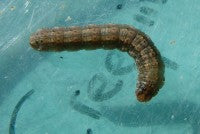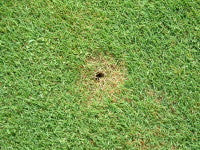Greasy Cutworm Identification and Control
This article was kindly provided by NZ Sports Turf Institute and written by :-
Brendan Hannan
Sports Turf Consultant
NZ Sports Turf Institute
Palmerston North
Anand Yadav
Technical Officer
NZ Sports Turf Institute
Palmerston North
Greasy cutworm (Agrotis ipsilon)
Cutworm belongs to a large group of night-flying moths in the family Noctuidae. This insect is wide spread, occurring in the United States, Europe, Canada, India, Japan, New Zealand, South Africa, South America, and the Pacific. Cutworm can be of significant economic concern to several cropping systems, including pasture, forage crops, vegetables, ornamental plants and turf grasses.
Greasy cutworm is found throughout New Zealand. The caterpillar, and resulting damage, is most commonly found in golf greens and cotula or starweed bowling greens during summer.
Life cycle
The normal summer life-cycle of the greasy cutworm lasts between 7 and 10 ½ weeks, depending on the weather and locality. Up to three generations a year may occur in the warmer parts of New Zealand, and usually two generations in the cooler parts. Both larvae and pupae overwinter and may take up to 6 months to develop.
The adult greasy cutworm is a moth, dark mottled brown to nearly black in colour, with a wingspan of about 40-55 mm. They are nocturnal in habit, strong fliers and are attracted to artificial lights. Adults do not cause any damage to turf.
On average an adult female can lay 600 to 800 eggs. The eggs are preferentially deposited on low vegetation singly or in random clusters. The eggs are about 0.5 mm in diameter and creamy white in colour when first laid. Within 24 hours, they turn light brown. After 3-6 days, the larvae hatch.
It is the larvae (caterpillars) that are the damaging stage of the life cycle. The larvae (caterpillars) have a brown head while the colour of the body changes with age. Young larvae are brown to greyish. Larger larvae are dark grey with two yellowish longitudinal stripes above and light grey below. A uniform pattern of black spots can also be observed on mature larvae. There are usually five instars (e.g. larval stages). The fully-grown final-instar larvae may be up to 50 mm long. When well fed, the larger larvae are plump and the skin has a shiny, greasy appearance. When the larva is disturbed it curls up into a ball. The larval period is of 25-35 days.

|

|
| Figure 1. Greasy cutworm larva. |
Figure 2. Greasy cutworm larvae curl into a ball when disturbed. |
When fully grown the larvae move into the pre-pupal stage where they stop feeding and make an earthen cell in the top 50 mm of soil. The pupal stage lasts 12-15 days. The pupae are reddish brown but darken as emergence approaches. When the moth emerges it forces its way to the surface of the soil before it expands its wings to fly.
Damage symptoms
In turf, greasy cutworm come to the surface and feed at night, cutting grass blades near soil surface resulting in a circular 'grazed' area around the burrow. They do not cast on the surface. It is the cutting-off habit (particularly in cropping), together with its appearance, which has earned this pest the common name of the greasy cutworm.
The cutworm damage on cotula and starweed bowling greens may be confused with the damage caused by cotula weevil (Steriphus variabilis). However the damage from cotula weevil tends to be browner, similar to heat stressed cotula.

|

|
| Figure 3. Cutworm caterpillar damage on fine turf. | Figure 4. Cutworm caterpillar damage on cotula. |
Control strategies
Management
There is not a lot that can be done to reduce the incidence of greasy cutworm. Regrettably essential spring renovation treatments for improving soil aeration, coincide with when the moth is present and provide an ideal 'home' for the developing larvae.

|
| Figure 5. Adult cotula weevil damage. |
Monitoring
As greasy cutworm does not cause severe damage nor does it occur in large numbers in New Zealand turf, it is best to wait for signs of damage before treating. To confirm the presence of cutworms, try drenching an area of affected turf with either 1 teaspoon of Yates Pyrethrum (5ml/L water) or 2 tablespoons of liquid dishwashing detergent (20ml/L). This irritates the caterpillars and forces them to the surface where they can be identified and counted. The presence of birds, particularly starlings and magpies foraging in turf areas is often an indication of cutworms and other surface-feeding insect pests.
Damage thresholds and the requirement for treatment will vary between venues and will typically be based on the number of larvae (burrows) present per green. As a guide, greater than 10 larvae per golf green or bowling green is a suggested starting point.
Chemical control
As greasy cutworm damage is generally not a major issue, it can typically be tolerated until other more damaging pests, such as porina, Argentine stem weevil or cotula weevil are present. Control can be achieved with a range of broad spectrum insecticides, including chlorpyrifos, diazinon, alpha-cypremethrin or lambda-cyhalothrin.
Where porina is controlled with diflubenzuron (Dimilin 25 W/Sniper), cutworm will not be controlled and a separate insecticide application may be required. Consequently correct identification of the pest is required to ensure the desired control is achieved.
An option to consider is 'spot treatments' to target specific caterpillar infestations instead of blanket application.
Alternative control
In New Zealand, bird feeding can often control the cutworms without the need for insecticides. However the birds can cause more damage to the turf in their search for the caterpillars.
Other control options include flooding them out when hand watering and squashing them on the surface or you can squash the cutworm inside their burrow by poking a small rod/wire/pocket knife down the holes.
Summary
Greasy cutworm is a minor pest in New Zealand sportsturf. It is typically found in fine turf, causing damage around aeration holes during the summer months. Cutworm are easily controlled with a wide range of broad spectrum insecticides. However, specific control is typically not required and this pest is usually controlled when treating more damaging turf pests that occur at a similar time.
References
Allan, D.J. (1998). Greasy cutworm life cycle. HortFACT.
http://www.hortnet.co.nz/publications/hortfacts/hf401011.htm
Hodgson, E.W. (2007). Armyworms and cutworms in turfgrass. UTAH pest fact sheet, ENT107 (07), pp1-3.
Wells, D. (1975). Caterpillars on the roll. NZ Turf Management Journal, pp18-20.
New Zealand Sports Turf Institute
163 Old West Road, PO Box 347, Palmerston North 4440, NEW ZEALAND
Ph: +64 6 356 8090 extn. 701 | Fax: +64 6 354 0081 | www.nzsti.org.nz
